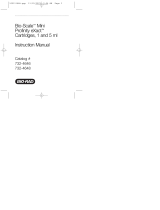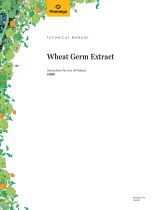Page is loading ...

Pierce™ Trypsin/Lys-C Protease Mix, MS Grade
Doc. Part No. 2162715 Pub. No. MAN0018080 Rev. A.0
WARNING! Read the Safety Data Sheets (SDSs) and follow the handling instructions. Wear appropriate protective eyewear, clothing, and
gloves. Safety Data Sheets (SDSs) are available from thermosher.com/support.
Product description
Protein characterization, identication and quantication by mass spectrometry (MS) begins with ecient, reproducible protein digestion.
Although trypsin is routinely used for protein digestion, this protease alone is not sucient to fully digest proteins at the carboxyl-end of lysine
and arginine residues. Therefore, Lys-C protease is commonly combined with trypsin to sequentially digest proteins with fewer missed cleavages.
Thermo Scientic™ Pierce™ Trypsin/Lys-C Protease Mix, MS Grade is a mass spectrometry (MS)-grade serine endoproteinase mixture formulated
for concurrent protein digestion providing more ecient digestion than with trypsin alone.
Contents
Product Cat. No. Contents Storage
Pierce™ Trypsin/Lys-C Protease Mix, MS Grade
A40007 20 µg/vial
Store at -20°C in a frost-free freezer.A41007 5 × 20 µg/vial
A41009 100 µg/vial
Additional information
• Reconstituted stock solutions of trypsin/Lys-C in 0.1% acetic acid are stable at 4°C for 1 month without signicant loss in activity. Store
reconstituted trypsin/Lys-C stock solutions at -20°C or -80°C in single-use volumes for longer-term stability. Minimize the number of stock
solution freeze/thaw cycles by aliquoting stock solutions of enzyme mix.
• Maximal trypsin/Lys-C activity occurs at pH 7-9; the protease mix is reversibly inactivated at pH < 4. Common digestion buers include
ammonium bicarbonate, Tris, HEPES, and TEAB at 20-100 mM.
• Trypsin/Lys-C is resistant to mild denaturing conditions including 0.1% SDS, 1M urea or 10% acetonitrile (ACN), which may be used to
facilitate digestion. Use of 6-8 M urea can reversibly inactivate trypsin for sequential Lys-C, tryptic digestion.
• High monovalent salt concentrations (i.e., >100mM NaCl) may interfere with protease mix activity. Addition of 1-10 mM CaCl2 to digestion
buers is optional and may improve digestion eciency for some proteins.
• Reduction with dithiothreitol (DTT) or tris(2-carboxyethyl)phosphine (TCEP) and alkylation with iodoacetamide (IAA) or chloroacetamide
(CAA), respectively, will cleave disulde bonds and modify cysteine residues to prevent disulde bond reformation. This improves digestion of
cysteine-containing proteins and detection of cysteine-containing peptides. Alkylation with IAA or CAA increases the mass of a peptide by
57.02 Da for each cysteine present.
Prepare enzyme mix
Reconstitute lyophilized trypsin/Lys-C in 0.1% acetic acid to 1 mg/mL (i.e., add 20 µL of 0.1% acetic acid to 20 µg of lyophilized trypsin/Lys-C mix).
Aliquot reconstituted enzyme mix in single-use volumes and store at -80°C.
Perform In-solution protein digestion
Note: The following protocol is an example application for this product. Specic applications will require optimization.
Materials required but not supplied
• 1M Tris, pH 8 (e.g., Fisher Scientic™ Product No. BP1758-100)
• Urea, sequanal grade (e.g., Thermo Scientic™ Product No. 29700)
• Ammonium bicarbonate (e.g., ACROS Organics™ Product No. 370930250)
• DTT (e.g., Thermo Scientic™ Product No. 20290 or 20291)
• IAA (e.g., Thermo Scientic™ Product No. 90034)
• Acetic acid (e.g., Fisher Scientic™ Product No. A35-500)
• LC/MS-grade water (e.g., Thermo Scientic™ Product No. 51140)
•(Optional) 0.5M TCEP (e.g., Thermo Scientic™ Product No. 77720)
•(Optional) SDS (e.g., Fisher Scientic™ Product No. BP1311-1)
•(Optional) Thermo Scientic™ Pierce™ C18 Spin Columns (Product No. 89870)
USER GUIDE
For Research Use Only. Not for use in diagnostic procedures.

Reduce and alkylate
1. Dissolve protein in 50 mM ammonium bicarbonate, pH 8 or a denaturing buer such as 50 mM Tris, pH 8 containing 8 M urea or 0.1% SDS.
Note: Use denaturing buers for full protein reduction, alkylation and digestion.
2. Prepare a fresh solution of 500 mM DTT by dissolving 7.7mg of DTT in 100µL of ultrapure water.
3. Add 500 mM DTT solution to protein sample to a nal concentration of 20 mM (1:25 dilution) and mix briey.
4. Incubate at 60°C for 1 hour or 95°C for 10 minutes.
5. Prepare a fresh solution of 1 M IAA by dissolving 93 mg of IAA in 500 µL of ultrapure water.
Note: Protect IAA stock solutions from light.
6. Add 1 M IAA solution to the reduced protein sample to a nal concentration of 40 mM (1:25 dilution) and mix briey.
7. Incubate the reaction mixture at room temperature for 30 minutes protected from light.
8. Quench the alkylation reaction by adding 500 mM DTT solution to a nal concentration of 10 mM (1:50 dilution).
Clean-up protein
1. Use acetone precipitation to clean-up the protein sample prior to digestion by mixing the sample solution with 6 volumes of cold acetone and
incubating at -20°C for 6-16 hours.
2. Centrifuge the suspension at 16,000 × g for 5 minutes to collect a protein pellet at the boom of the tube.
3. Dissolve the reduced/alkylated protein pellet in your digestion buer, such as 50 mM ammonium bicarbonate, pH 8 or a denaturing buer
such as 50 mM Tris, pH 8.
Digest
1. Add trypsin/Lys-C solution to the sample to a nal protease to protein ratio of 1:20 to 1:100 (w/w).
Note: Protein samples dissolved in 8 M urea must be diluted to <1 M urea for complete digestion. For SDS-containing samples (<0.1%),
dilution is not necessary.
2. Incubate the sample at 37°C for 2-16 hours.
3. Store samples at -20°C or acidify by adding formic acid to pH <3 to stop digestion reactions. Before MS analysis, clean up samples with
reversed-phase spin columns (e.g., Pierce™ Peptide Desalting Spin Columns, Product No. 89852).
Perform in-gel protein digestion
Note: This procedure is for colloidal coomassie-stained or uorescent dye-stained acrylamide gel slices. Alternative destaining procedures are
required for silver- or zinc-stained protein bands. Use sucient reagent volumes to completely cover gel-slice pieces for all steps. Use LC/MS-grade
reagents, clean containers and gloves to minimize contamination.
Materials required but not supplied
• Ammonium bicarbonate (e.g., ACROS Organics™ Product No. 370930250)
• 0.5 M TCEP (e.g., Thermo Scientic™ Product No. 77720)
• IAA (e.g., Thermo Scientic™ Product No. 90034)
• Acetic acid (e.g., Fisher Scientic™ Product No. A35-500)
• LC/MS-grade water (e.g., Thermo Scientic™ Product No. 51140)
•Triuoroacetic acid (TFA), sequencing grade (e.g., Thermo Scientic™ Product No. 28904)
• Acetonitrile (ACN) (e.g., Fisher Scientic™ Product No. 51101)
• Pierce™ C18 Spin Columns (Product No. 89870)
• Vacuum concentrator (e.g., Thermo Scientic™ SpeedVac™ Vacuum Concentrator)
Perform SDS-PAGE and destain
1. Separate proteins by SDS-PAGE and stain gel using a reversible, colloidal coomassie stain such as Thermo Scientic™ GelCode™ Blue Stain
Reagent (Product No. 24590).
2. Using a clean razor blade, cut gel slices containing stained proteins and transfer 1 × 1 mm pieces of gel to a microcentrifuge tube.
3. Add 200 µL of 100 mM ammonium bicarbonate/50% ACN to gel slices and incubate at 37°C for 30 minutes to destain the gel slices.
4. Remove destaining buer and repeat the previous step twice or until all stain is removed.
Reduce and alkylate
(Optional)
1. Prepare new 5 mM TCEP solution by diluting 10 µL of 0.5 M TCEP in 1 mL of 100 mM ammonium bicarbonate.
2. Add 5 mM TCEP solution to the destained gel slices and incubate at 60°C for 10 minutes.
3. Prepare new 100 mM IAA solution by dissolving 9.3 mg iodoacetamide in 1 mL of 100 mM ammonium bicarbonate.
4. Remove TCEP solution from the gel slices. Add 100 mM IAA solution and incubate sample at 37°C for 15 minutes with shaking.
5. Remove IAA solution from gel slices. Rinse gel slices with 100 mM ammonium bicarbonate/50% ACN and incubate sample at 37°C for 15
minutes with shaking.
6. Repeat the previous step twice to remove excess IAA from gel slices.
2
Pierce
™
Trypsin/Lys-C Protease Mix, MS Grade User Guide

Digest
1. Shrink gel pieces by adding 50 µL of ACN. Incubate sample for 15 minutes at room temperature.
2. Remove ACN and allow gel pieces to air dry for 5-10 minutes.
3. Dilute 1 mg/mL trypsin/Lys-C stock solution to 0.01 mg/mL using 100 mM ammonium bicarbonate (1:100 dilution).
4. Add 50 µL of 0.01 mg/mL trypsin/Lys-C solution to the sample and incubate the tube at 37°C for 4-24 hours.
5. Remove the digest solution and transfer to a new microcentrifuge tube.
6. Extract the gel pieces 3 times by adding 50 µL of 50% ACN/0.1% TFA solution and incubating at 37°C for 5-15 minutes.
7. Combine gel extracts with digest and evaporate the liquid using a vacuum concentrator.
8. Clean-up samples with C18 spin columns (e.g., Pierce™ C18 Spin Columns, Product No 89870).
Troubleshooting
Observation Possible cause Recommended action
Excess background noise during LC-
MS.
Buffers, salt, or urea interference. Clean-up sample before analysis with reversed-phase tips or spin
cartridges (e.g., Pierce™ C18 Spin Columns).
Incomplete alkylation or incomplete
recovery of alkylated peptides.
Used old or inactive iodoacetamide
solution.
Prepare iodoacetamide solution immediately before use and protect it
from light.
Incomplete sequence coverage. Incomplete digestion. Reconstitute enzyme mix immediately before use and use the
appropriate digestion buffer.
Add mild denaturants, such as 0.1% SDS, 1 M urea or 10% ACN to
facilitate digestion.
Too few, too many, or unevenly
distributed protease digestion sites.
Separately use multiple proteases to digest the sample and combine
results (e.g., multi-consensus reports in Thermo Scientific™ Proteome
Discoverer™ Software.
No digestion. Incorrect pH or buffer conditions. Verify buffer pH is between 7-9.
Reduced enzymatic activity. Reconstitute enzyme mix immediately before use and make single-use
volumes to avoid multiple freeze/thaw cycles.
Over-alkylation. Alkylation was allowed to proceed for
too long.
Alkylate at room temperature for 30 minutes and quench reaction with
10 mM DTT.
Precipitation after alkylation. Too much reduction/alkylation buffer
for quantity of protein being digested.
Quench alkylation reaction using 10 mM DTT.
Related products
Product Product No.
EasyPep™ Mini MS Sample Prep Kit A40006
Pierce™ Trypsin Protease, MS Grade 90057
Lys-C Endoproteinase, MS Grade 90051
Glu-C Endoproteinase, MS Grade 90054
Asp-N Endoproteinase, MS Grade 90053
Chymotrypsin Endoproteinase, TLCK treated, MS Grade 90056
LysN Protease, MS Grade 90300
Pierce™ Trifluoroacetic Acid (TFA), Sequencing Grade 28904
Formic Acid, LC-MS Grade 28905
Limited product warranty
Life Technologies Corporation and/or its aliate(s) warrant their products as set forth in the Life Technologies' General Terms and Conditions of
Sale at www.thermosher.com/us/en/home/global/terms-and-conditions.html. If you have any questions, please contact Life Technologies at
www.thermosher.com/support.
Thermo Fisher Scientific | 3747 N. Meridian Road | Rockford, Illinois 61101 USA
For descriptions of symbols on product labels or product documents, go to thermofisher.com/symbols-definition.
The information in this guide is subject to change without notice.
DISCLAIMER: TO THE EXTENT ALLOWED BY LAW, THERMO FISHER SCIENTIFIC INC. AND/OR ITS AFFILIATE(S) WILL NOT BE LIABLE FOR SPECIAL, INCIDENTAL, INDIRECT,
PUNITIVE, MULTIPLE, OR CONSEQUENTIAL DAMAGES IN CONNECTION WITH OR ARISING FROM THIS DOCUMENT, INCLUDING YOUR USE OF IT.
Important Licensing Information: These products may be covered by one or more Limited Use Label Licenses. By use of these products, you accept the terms and conditions of all
applicable Limited Use Label Licenses.
©2018 Thermo Fisher Scientific Inc. All rights reserved. All trademarks are the property of Thermo Fisher Scientific and its subsidiaries unless otherwise specified.
thermofisher.com/support | thermofisher.com/askaquestion
thermofisher.com
31 October 2018
/












